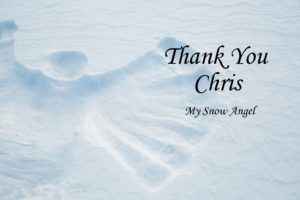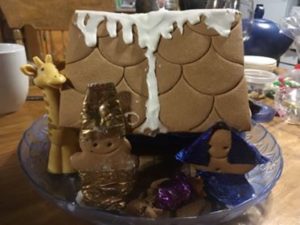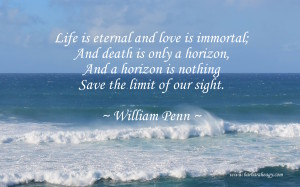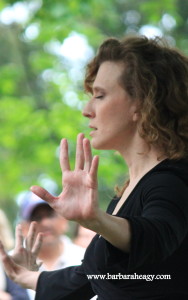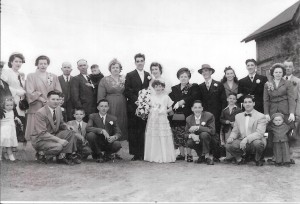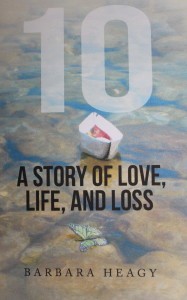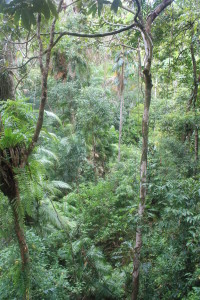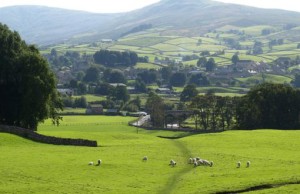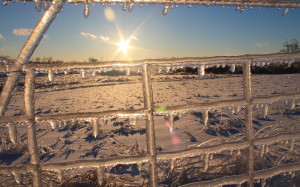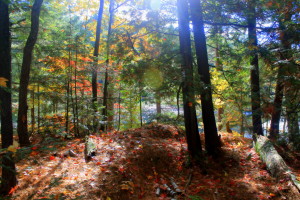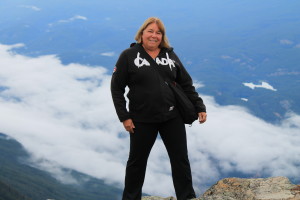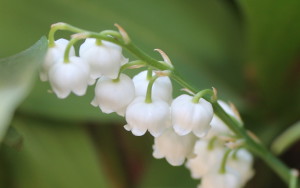Author: barbaraheagy10@gmail.com
Friends and Christmas Memories
This week a group of friends, all working and/or retired teachers, celebrated our Christmas pot luck dinner. I drove almost two hours one way to see them, as I do every month, but I love this group of friends and am willing to do it. We always go to Anne and Bobby’s log cabin home set back off a country road, surrounded by forest and fields. Years ago, they built this beautiful log home mostly by themselves; they dug their own well and set themselves up to be as self-sufficient as possible. They have a deep sense of stewardship for the earth and live as simply as possible. Their home is cozy and warm and I always feel welcome.
The group, as a whole, is creative and fun. We always go for a hike before dinner, enjoy our meal and then often play board games or share photos and conversations of recent trips or events. This month we had a celebrative Christmas party.
I arrived a little late and found Bobby putting the finishing touches on a Christmas tree set up in the corner. I complimented him on his choice, assuming that he had cut down one of the many trees on his property. He invited me to come take a closer look. I was amazed! He had found a dead maple tree trunk, put it in a pot and using fresh spruce boughs and a drill and ingenuity, inserted the live boughs to create a truly beautiful little Christmas tree.
“Would you call this a fake live tree or a live fake tree?” he laughed.
We always pick a theme for our dinner. This month, because it was Christmas, we all made ‘ginger’ dishes. There was carrot ginger soup, cheese and ginger mini sandwiches, ginger flavoured cheese, a stirfry with ginger sauce and rice, ginger and cabbage salad, ginger molasses cookies, chocolate covered candied ginger, and a lemon grass/ginger bubbling beverage.
After dinner we constructed a gingerbread house that turned into a gingerbread stable when one of the walls collapsed. We had lots of laughter and fun as each of us contributed to the Christmas creche we spontaneously created with two gingerbread figures for Mary and Joseph. A bright candy wrapper became a swaddling blanket for the baby Jesus, a tiny toy figurine Anne found that looked more like a tiny alien than a baby, and we stuck him into a gingerbread molasses cookie cradle. A plastic toy giraffe became the ‘donkey’ that carried Mary and Joseph to Bethlehem. Lyn, with a huge amount of patience, finished off the final touches to the gingerbread stable with candies and chocolate.
We exchanged gifts and cards: Moraine had a friendship bracelet for each of us, brought back from her recent trip to Guatemala; Lyn had hand-made soaps and toothpaste she had made at a local workshop; I handed out my own photo Christmas cards and Anne and Bobby gave us each a copy of their annual “Egbert Courier” newsletter.
Kathy brought a Christmas trivia game and we had fun asking each other questions and trying to come up with the correct answers as a group. Many of the questions had to do with Christmas carols and each time one came up, we would stop the game and sing a Christmas song together with Anne playing piano and Bobby his violin.
At the end of the night, we dimmed the lights, and with musical accompaniment and two part harmony, we sang “Silent Night” in unison. With lots of hugs and kisses, we said our goodbyes and wished each other a Merry Christmas.
For me, this was a memorable evening that I will treasure for years to come. It was the simple things that counted the most: good friendships, a tasty meal, music, hand-made gifts, and lots of laughter and spontaneity.
Merry Christmas to all. I pray that you too will have a memory-filled, happy holiday season.
Life is Eternal, Love is Immortal
Yesterday my Snack ‘n Chat group that meets weekly had one of our potluck lunches. One of the women has been recently widowed after forty-seven years of marriage and she told us a beautiful story about the loss of her wedding ring in a local store shortly after her husband’s death and its miraculous recovery.
For two weeks after the loss of the ring, she returned to that store over and over again, asking in different departments and areas of the store if it had been found. No one had seen it.
Again this week, she asked a young clerk if the ring happened to be under the cash area on a shelf perhaps. It wasn’t. My friend moved on to do more shopping and the young girl went to talk to one of her friends in the store. The next thing my friend heard was her name being called over the P.A. system. She was to return to the same counter again.
“Now, I don’t want to get your hopes up,” the young girl said. “We have found a wedding ring. It may not be yours. Security is bringing it to us.”
They all watched with anticipation as a uniformed guard approached. He stood before them and pulled out a clear plastic bag from his pocket. Inside was the wedding ring!
My friend was overjoyed and broke out in loud squeals and a mixture of tears and laughter. The clerks and guard all joined her causing a joyful ruckus that could be heard throughout the store.
Where had the ring been all this time? No one was sure but my friend’s persistence and prayers paid off.
We each shared stories that day about miraculous events after the loss of a loved one. One woman felt her deceased husband had visited her in the night leaving a kiss on her lips. Another spoke of a knock at a door, and her deceased father entered the room, fully clothed, in the flesh. She felt he had returned so she could say a final goodbye to him. I shared my story of a medium’s message of eternal love and gratitude from my beloved Tom.
I found it quite amazing that four women had four stories about miraculous events after the loss of a loved one. We tend to not talk of these things in our society. I believe there are more stories out there. It appears that our loved ones do go on and can send us signs and symbols from eternity. Love lives on.
The Still Point of the Turning World
This week Wendy Roman, of Rhythmwood Dance Studio, asked her Facebook readers what the phrase “Effortless Effort” means to them through dance. Another reader and dancer, Laine Magidsohn, suggested it be called “Dynamic Ease.” I like both phrases. Both phrases speak of finding that balance between active participation and passive release.
I think ‘Effortless Effort’ and ‘Dynamic Ease’, are both phrases of just stepping aside for a moment to connect with life’s energy force. Letting it flow within, embodying it, giving it room to become one with me and then moving forward together. I don’t just step aside and let it take me over. We work together, side-by-side, internally as one. One body, one flow of energy.
When I was getting my MA in Dance at York University, my thesis centered on finding the relationship between creativity and spirituality. I held a day long workshop of movement and dance, journaling and oral sharing. Later in evaluations of the experience, two of the participants spoke of finding ‘stillness’ in the ‘movement’ while they danced. A paradox. After the event, one of the participants gave me a beautiful hand-made calligraphy copy of an excerpt of T. S. Eliot’s “Four Quartets – Burnt Norton.” For her, his poem spoke of finding “The Still Point of the Turning World” and acted as a metaphor for her experience.
From T. S. Eliot’s “Four Quartets – Burnt Norton”:
“At the still point of the turning world. Neither flesh nor fleshless;
Neither from nor towards; at the still point, there the dance is,
But neither arrest nor movement. And do not call it fixity,
Where past and future are gathered. Neither movement from nor towards,
Neither ascent nor decline. Except for the point, the still point,
There would be no dance, and there is only the dance.”
Finding that balance of stillness and movement is a form of active release. It means standing still for a moment, breathing, centering myself, becoming deeply aware of all that is around me so that I can connect with the movement of life and its energy and begin to move as one with it. It’s becoming as T. S. Eliot calls ‘The Still Point’ so that I become the axis around which my world turns. I am integral to its being. I support it, as I become the stillness from which the movement circulates. The world rotates around me, life happens, but I am always centered and strong, actively a part of it, and deeply aware of the bonded process. It’s finding “The Still Point of the Turning World” within myself.
Gramma’s Gift
Yesterday, I was challenged to write a 50 word story about a box found in my deceased grandmother’s attic. The box had my name on it. What was inside?
Being a third generation Hungarian on both sides of my family, I have often wondered about my ancestral line. I was too young and busy in my life to care before my great-grandparents, grandparents, and parents died with all their stories and information. Tracing my ancestry is made more difficult by the fact that my grandparents surname was changed to a more Anglicized version that was easier for English tongues to say. Who knows what the original version is and how would I get that information?
My birth father died of cancer when I was just seven years old and mom remarried when I was nine. My life took a new direction and we began to see my original birth family on my father’s side less and less. It was a large family, nine brothers and sisters who married, had children and produced a large number of cousins for me and my brother and sister. I have seen them on occasion, but it was usually at a public or social function and as the years passed it was infrequent.
This past year I took a therapeutic touch workshop at my local YMCA/YWCA. I arrived early and sat down next to a man, the only other participant there. As the teacher was giving us our handouts, I turned to say something to him. My mouth dropped open!
“Uncle Frank!”
He looked confused until I said, “It’s Barbie, your niece.”
A big smile creased his face and after that we enjoyed reminiscing and spoke of old times until the class began. We decided that we would get together for a coffee some day and he agreed to help me fill in some of the holes in my memories and knowledge of my family.
Well, of course, some day never came until Glynis Belec’s online challenge to write the short 50 word story. I began researching my pet name ‘Boriska’ that I was called from birth by my mother’s Hungarian side of the family and was confused by what I found. I also wanted to find a Hungarian symbol that would be suitable as a potential gift to me from my grandmother. Neither searches were easy to do what with spelling and other nationalities mixed in with the results.
I decided to call Uncle Frank. He lives here in my own town. He answered a few of my questions but I wanted more information. We agreed that we would get together for coffee and a chat about our families in a couple of weeks. The date is set and written on my calendar and I am looking forward to it.
How much do you know about your ancestral line? I have learned that the sooner you get that information from your family, the better. Time has a habit of slipping away and all that information goes with it as family pass on.
Here’s my little 50 word story. It’s fictional but it reflects my Hungarian heritage.
Dad handed me the small velvet box. On it was a small tag with one word, ‘Boriska.’ Gramma’s pet name for me since I was a baby.
“I found it in her attic.”
Inside was a silver pendant of twisted leaves and a heart, an ancient Hungarian symbol of love.
Glynis, my author friend, gave us a great little writing prompt. It encouraged me to think deeper about my cultural background. Why don’t you try it? What would be in your box?
Choose to Live
At a recent writer’s retreat I attended, I was sharing my published books with another new writer friend. An author has to be able to say what his or her book is about in under 30 seconds, one or two sentences at the most. My keynote for my first book is “10 – A Story of Love, Life, and Loss, is an inspiring cancer story. It may uplift and encourage you to live your best life.” I often say “It’s an inspiring memoir/cancer journey/love story.”
Then, my friend asked me a simple question, one I had never been asked before so succinctly.
“So, how do you continue to live a quality life when you’ve been given a terminal diagnosis with no hope of a cure?”
Her succinct question demanded a succinct answer. She wanted to know in a few sentences how my husband and I did it.
I answered her this way, in list form: change your focus to ‘living’ rather than ‘dying,’ live in the moment, live with gratitude, and focus on your abilities, not your losses.
- Focus on ‘living’ every day, rather than ‘dying.’ You try to fill your day with as many life-fulfilling activities and people as you can, and you focus on those positive messages and feelings, rather than negative people, circumstances and thoughts.
- Live in the moment, with mindfulness, tapping into all your senses. Taste that juicy apple, smell that scented rose, look up at the sky and the clouds floating by, feel the softness of your child’s cheek, listen to the sounds of nature all around you. Often, the simplest things are the most meaningful.
- Live with gratitude. Say thank you. When you awake, be grateful for another day given, and when you go to sleep, say thank you for all you received.
- Focus on what you can do, rather than what you can’t do. In spite of impending losses, you still are capable of many things. Use your time to enjoy doing those things you can still do.
“10 – A Story of Love, Life, and Loss’ is a story of struggle, pain and loss, but at the heart of it, it is a story of love, hope, and strength. It is a story that may help others who have been given a life-debilitating diagnosis, as well as helping their caretakers and loved ones who journey with them.
My book can be purchased at The Bookshelf, Guelph; BookLore, Orangeville; Hannelore Headely Old & Fine Books, St. Catharines and Spa Wellness Tamara, Guelph. It can also be purchased directly from me by messaging me. Buy it online at amazon.ca.
A Path to Creativity
Back in the mid 90’s I was teaching a Gr. 1 class at a small country school. One of my student’s parents offered to write our Christmas play and so began a new friendship based on our mutual enjoyment of writing. Jane introduced me to a book called The Artist’s Way – A Spiritual Path to Higher Creativity by the author Julia Cameron.
It was a book on the link between creativity and spirituality and included a 12 week program of basic principles and activities that rekindled one’s latent creativity and helped one to overcome problems such as self-esteem, self-criticism, jealousy, guilt and other factors such as worry over time, money or support, all blocks to our creative energies. Cameron believed that we all are creative beings, that there is not one non-creative person alive. She also believed that the universe is naturally creative and creative expression is the natural direction of life. This resonated so deeply within me as, decades before, in my university years in the early ‘70’s I had studied fine arts, modern dance and drama and experienced a new-found confidence in my own creativity abilities. I, too, believed vehemently that we all are creative beings.
During the ‘80’s, my child bearing years, my life had become very busy with family obligations and yet, during this time, I did manage to work professionally with a dance company in Toronto and returned to university in 1988 to earn a Bachelor of Education. Working full-time, raising a family and working through a difficult marriage didn’t leave much time for dance activities any longer. In the early 90’s my husband and I separated and a new life began. I was longing for a new outlet for my creative energies.
Cameron’s book provided me with that. For 12 weeks, I worked through her book, chapter by chapter, every day writing what she called “morning papers.” Each day I sat down with three blank sheets of paper and in a stream-of-consciousness format, I filled those pages. She said to fill them up from beginning to end, even if all I could write was “I don’t know what to write. I don’t know what to write.” She said, if you kept writing, pretty soon something of value was going to come out on that page. I wrote a lot of garbage back then but there were also many true gems of wisdom. I found by writing this way, it released my creative energies and I often found my soul revealed on the page, answering problems that I had fretted over for weeks.
She also told you to take an “artist date” once a week. It could be anything: go visit a fabric store, walk along a quiet river, visit a museum or go watch a parade. You were allowed to do anything at all that helped to rejuvenate, replenish or inspire you. It was to be done solo, was to be fun and festive and was to be filled with play. She said that we work so hard at being artists that we need to give back to ourselves and find the play in our creative process once again.
At the end of the 12 weeks of exploration, Cameron challenged you to set a creative focus for yourself that would work in your life. You were to set a basic goal, the steps you would go through to achieve that goal, and the time frame it would take you. You were to find a mentor that would encourage, guide and prod you along and you must meet with your mentor once a week until the goal was achieved. I chose to focus on writing, to have something published, even if it was only in a small way and I met with my friend Jane in her home, once a week. I continued to write morning papers and we had a lot of fun giving each other small prompts for creative, spontaneous writing and sharing these with each other. At the end of my weeks with her I did achieve my goal and an article on creativity was published in a provincial drama educator’s newsletter.
Cameron’s book opened up a new world of writing to me. I had always enjoyed writing but she inspired me to explore my writing further and she gave me a means of goal-setting and finding success with my chosen creative field. I would recommend this book for anyone who feels blocked in their creative field. If you are willing to work through her program from beginning to end, you will achieve success – and have a lot of fun doing it. Get those creative juices brewing. Go play.
Sometimes I Climb Mountains
Sometimes I climb mountains and stand on snow-covered peaks and watch a rolling panorama of clouds drift by all around me. Down in the valley the world sits, a miniature grid of rivers and roads and towns, people busy in an existence that doesn’t involve me as I stand in heaven detached from it all. I stretch my arms wide open into a clear blue sky and inhale deeply the pure bliss of it all.
. . . But it’s not home.
Sometimes I swim in aquamarine oceans, floating, bobbing gently over waves and watch a world of colour bubble below me. Coral in rainbow hues, shapes and sizes that stretch the imagination with brain-like humps, tree-like projections and wispy tendrils sway in the ocean current in oranges, pinks, blues, and purples. Fish, hundreds of them in every shade ever created, swim in undulating schools around me. Clams, lying on the ocean floor, display their neon-blue interiors to a watery world. Larger waving creatures swim lazily by, leaving dark shadows in the distance. I think I could float forever in this wondrous world of mystery and beauty.
. . . But it’s not home.
Sometimes I wander the Garden of Eden, a tropical world of scented flowers, twisting vines and tall palm trees. The sun warms me as I close my eyes and let its rays penetrate my bones. I am unencumbered with loose, flowing clothes; the gentle breezes cool and lift my spirit. This is a world of turquoise, lime and pink, pastel colours that soften the soul. There is no rushing here, no hastiness to complete a day. Just quiet and gentleness that soothes and comforts and says, “Breathe. Relax. Rest in this tranquillity.”
. . . But it’s not home.
Sometimes I walk cobblestone lanes lined with thatched roof cottages. Patchwork fields, edged in hedgerows and cows, stretch over rolling hills. Herds of bleating sheep compete for space as I wander down dusty roads and across fields of grass. Ancient stories reside here in monolithic rocks, rising in circles that speak of ritual and magic. Fairies dance in the morning dew and the dark forests hide secrets of beastly denizens. History is told over pints of foaming brew and pots of steeped tea as smiling faces invite me in to sit by the fire. I am welcome here.
. . . But it’s not home.
My home is maple trees running thick with sap in the spring. It is flowers bravely peeping up through melting snow in bright slashes of colour. In the summer, I can float in a cool, clear lake and watch schools of fresh-water fish swim deep through underwater canyons. Here I stand in awe of a red, orange and gold vista that stretches across a countryside in autumn glory. Snowflakes fall gently on my hair and eyelashes, frozen icicles sparkle in the cool sun, blankets of purity coat a white world of winter wonder. Limestone escarpments, rushing waterfalls and towering pines compete with soaring skyscrapers and ribbons of highway that stretch from coast to coast. This is a big country, resplendent with natural wonders and a hard-working people comfortable in their own skins. This is where I belong, my birthplace. The cool waters run through my veins, granite and limestone form the bedrock of my soul. Canada.
This is home.
A Perfect Day
I opened my eyes, adjusting to the morning light streaming through the crack in the curtains. Byron, my daughter’s dog, had decided to sleep with me last night and once he realized I was awake, he covered my face with kisses in anticipation of a morning walk. He waited patiently while I dressed and we quietly stepped outside onto the back lawn with its cloak of morning dew. Spring flowers were bursting, birds were singing.
Back inside, I started the morning coffee, turned on the computer, and then stuck my head in to see if my daughter and grandson were awake. There they were, in the middle of a morning feed, throwing smiles and kisses my way. Within a few minutes, my daughter brought my little grandson, just nine weeks old, out for morning cuddles while she slept a little longer.
He watched me as I finished my morning writing and emails, those bright Wedgewood Blue eyes not missing a beat. As our gaze caught, his big smile filled my heart.
Maegan woke up and after another bit of visiting, she left for a good long run with the dog along the river trails. My little guy and I had more cuddle and smile time. Holding a little baby in your arms is a precious thing.
When she and the dog returned, a bountiful breakfast and good conversation made for an easy-paced morning. Before I knew it, they had to go to head off for an appointment later in the day.
As I waved goodbye, I said a quiet prayer of gratitude for the love of my daughter, her little guy, and her beloved pet.
I got some computer work finished, notices, letters of thanks, and future appointments and retreated out to the back patio with my book and a warm cup of tea for the rest of the afternoon. The sky was blissfully blue, the birds were still singing, butterflies were dancing and a gentle breeze kept me cool in the warming sun.
Ah . . . this day couldn’t be better. Simple pleasures of shared family love, good food, good conversation, sunshine, spring flowers, butterflies and birds are all I need in my life. At least for this day. This perfect gem of a day.
Good Grief
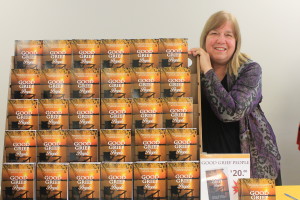 We had a very successful book launch. Thank you to all who came out. Here is my speech:
We had a very successful book launch. Thank you to all who came out. Here is my speech:
The first thing I want to say is how honoured I have been to be a part of this very special book, Good Grief People. I knew none of these authors, except for a slight acquaintance with Donna Mann, until we began working on the manuscript last year. Glynis M. Belec, Carolyn Wilker, Ruth Smith Meyer, Donna Mann, and Alan Anderson, I now count you as best friends, my BFF’s, and I admire and respect you all so much. My friends have taught me much about death, dying, and the grief process.
I’ve done a lot of thinking about what ‘good grief’ is. And now that I see the book in its final form with all our stories and poems, I think I would have this to say about good grief.
Good grief is about bravery, sensitivity, acceptance, and a generous, fearless attitude to life.
Grief is much like falling in love – to do it well, we have to drop the barriers holding us back from fully stepping forward into it. Yes, it’s a powerful emotion, as powerful as love. But that’s what grief is – love. When we have loved deeply, we grieve deeply.
Good grief means facing the fear, the anger, and processing it in good faith. It’s about examining one’s life and finding new purpose and a new identity. It’s about a willingness to live and find a new you.
Like a woman in labour, who works with her body and mind to embrace the pain, to release it instead of fighting it and bottling it up, when I grieve well, I learn to ‘go with the flow’. These stories have taught me that I can birth myself into a new identity. It will be a world without you, a different world, but I will still be in it and will find my new life.
Grief is like a wounded athlete who learns to work through an injury, strengthening the other muscles and joints to heal an injury to regain our health and wholeness once again. Grief can be like an amputation, and when you think about it, losing someone dear to you is like losing a part of yourself. But even through that, we can learn to do things in a new way and go on.
Good grief is the fork in the road, and although we may hesitate, we choose to take it in good faith. It’s the willingness to continue the journey, a journey into the unknown.
Good grief is the willingness to accept the end of one story and move on to the next chapter or book. We all have our favourite books and stories that we just hate to see end. We stretch out the best parts, savour it, read it again slowly, or even stop reading because we can’t bear for it to be over. But it does come to an end. And then we move on to the next story, but not until we have placed that story in our ‘favourite books’ shelf for safe-keeping and re-reading. We know that we can return to it again and again, but we know too that it will never be the same as that first time experience.
I hope that our book, these stories, will help you find hope in the midst of despair, comfort from the pain, joy in the sadness, strength out of the weakness and acceptance in the midst of denial. They all sit on the same plate. We can learn to live with both.
